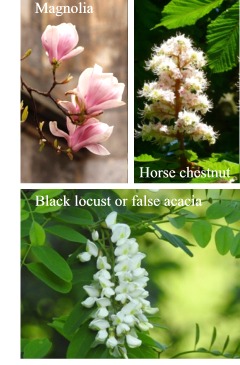There's something about blossom
Plants, 25 April 2019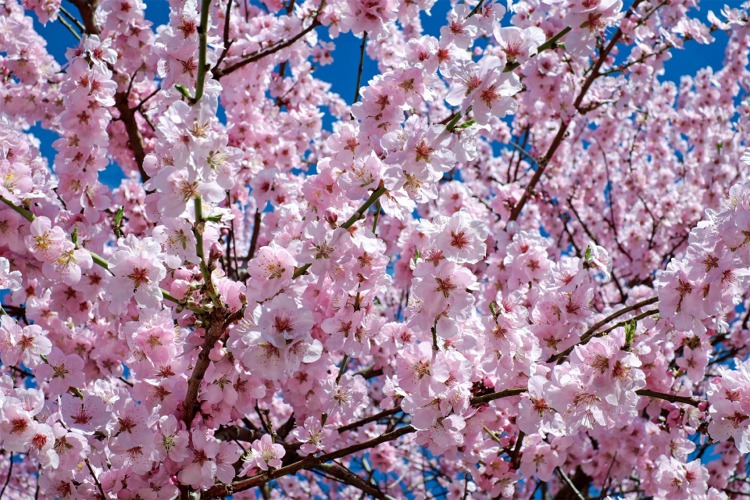
Everybody knows blossom. It's the thousands of little white or pink flowers that appear on fruit trees, to tell you that spring is really here.
There can be so many flowers on a cherry tree in a park that it looks like a white or pink cloud.
What exactly is blossom?
Blossom is flowers on a tree.
There are thousands of species of flowering tree, and probably we've all seen a tree covered in thousands of flowers. In normal English, it's OK to call all those flowers "blossom", but that's not the technical definition.
For a naturalist, blossom is the flowers on certain fruit trees, in large numbers and with a short life. "Blossom time" is just three weeks in April (or sometimes in March or May, depending on the species and the local climate).
Let's start with some tree flowers that technically aren't "blossom".
You probably know the magnolia tree, which has lots of big pink-and-white flowers any time from February to June. When you can easily see big individual flowers, that's not blossom.
I'm writing this article during a visit to my mother's home in south-east England, and I can see two flowering trees from here: There's a horse chestnut (Aesculus hippocastanum) and a black locust or "false acacia" (Robinia pseudoacacia). Horse chestnuts have groups of about 25 flowers in "candles" up to 30cm tall. Black locust trees have lots of small white flowers in summer.
They're not really "blossom" either, because blossom comes for just a short period in spring; each flower is small or very small; together they often make the tree look like a cloud of flowers; and blossom is delicate, so when there's a strong wind or heavy rain, lots of it gets blown off.
Also, magnolia, chestnut and black locus aren't fruit trees. To a naturalist, it's only certain fruit trees that have blossom.
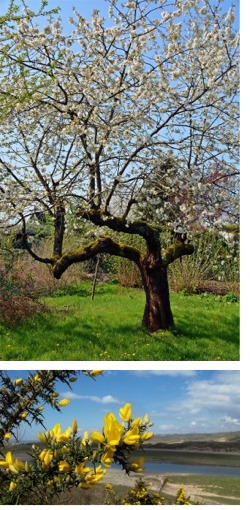
Technically, the blossom trees are the ones that have pome fruit or stone fruit. The main pome fruits are the apple (Malus) and the pear (Pyrus), plus some less common trees like the quince (Cydonia oblonga) which has fruit like small lumpy pears. Hawthorn (Crataegus monogyna) is also a pome fruit tree, even though it only produces small red berries. It certainly has clouds of white blossom in April.
Stone fruit comes from trees in the Prunus family. In Britain, that means the cherry, the plum, the damson and the blackthorn. My mother's county of Kent is famous for its cherries. Other trees in the Prunus family (apricot, peach, nectarine and almond) produce blossom in countries that have hotter summers, but not so much in Britain.
Gardeners have used selective breeding to produce "ornamental" cherry trees, where the blossom is more important than the fruit. See the photo at the top of the page. This makes blossom time a special month in gardens and parks all over the world and especially in Japan, where everybody goes to look at the blossom of the sakura (桜, the Japanese cherry, Prunus serrulata).
The English language always has a few exceptions to every rule. Botanists may say that only pome fruit and stone fruit trees have blossom, but to many people, "blossom" means any cloud of flowers on any tree or bush, including the orange tree (Citrus x sinensis) which can have strong little white flowers at any time of year. And some members of the Oleaceae family like the olive (Olea europaea) and jasmine (Jasminum). And even gorse (Ulex europaeus), which is a prickly bush. It grows in wild places such as hills, dunes and marshes, and it can have little yellow flowers at any time of year. They smell wonderful, a bit like coconut.
What is blossom for?
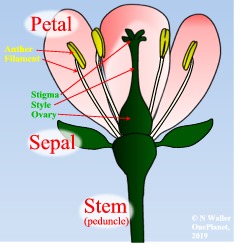
Nearly all flowers are for pollination. No pollination means no fertilisation; no fertilisation, no seeds; no seeds, no fruit.
Male part: The stamens are the male parts of the flower that produce pollen. A stamen consists of a long, thin filament, with an anther on the end. The anther is often bright yellow, the colour of the pollen.
Female part: The pistil is the female part of the flower. The pistil consists of the ovary, with the style on top of the ovary, and the stigma on the end of the style.
Inside the ovary, there are ovules. Pollination occurs when a single grain of pollen lands on the stigma and germinates. After germination, the pollen grain sends a pollen tube down the style and into the ovary, where it makes contact with the ovule. This fertilises the flower, which then produces a seed inside the ovary. The ovary gets bigger and becomes the fruit.
Most varieties of fruit tree need to be cross-pollinated by pollen from flowers on a different tree. A few varieties of fruit tree are self-fertile, so they can produce seeds and fruit using their own pollen. Self-fertile trees include European plum trees, sour cherries (but not sweet cherries) and some apple varieties.
At the end of blossom time, the white or pink petals fall off. However the sepals (which are like petals but green) don't fall off. Nor do the stamens or the style.
After pollination, a fruit starts to develop as a small bulge at the base of the flower.
The bulge gets bigger and becomes a fruit, but the flower doesn't disappear completely. If you look at the base of an apple or a pear, the brown star and little brown hairs are the remains of the flower's sepals, stamens and style. If you look at the other end of an apple or pear, you'll see a strong brown stem. This started off as the stem (or peduncle) that attaches each blossom to the tree.
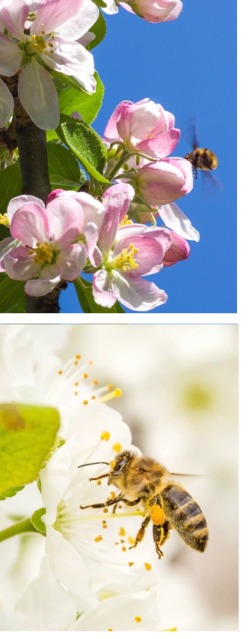
Pollen can't get from one fruit tree to another on its own. Some plants, including grasses and pine trees, produce lots of tiny pollen grains, which are so light that they can let the wind do their pollinating. This kind of pollen is bad news for people who have pollen allergies or "hay fever".
Fruit tree pollen is too heavy for the wind. It's also slightly sticky, so it sticks to insects as they go from flower to flower. The main pollinators for fruit trees are bees, of which there are many species. Other pollinators include hoverflies (Syrphidae), wasps (Vespidae), butterflies and moths (Lepidoptera), diptera flies, and birds.
With a stone fruit such as an apricot, the seed is inside the stone. With an apple, there are seven to ten seeds (or apple pips) inside each fruit.
It's very unlikely that one apple blossom will get enough pollen to fertilise seven to ten seeds from just one visit by an insect. It needs lots of visits, by lots of insects, or it will only have a few seeds. From the apple tree's point of view, an apple with only one or two seeds is a waste of time, so the tree will probably let it fall to the ground long before it gets ripe (a fruit is ripe when it's ready to eat).
If you're an apple tree, and you want each of your blossoms to be visited ten or twenty times by insects that have already visited other apple trees, what do you do?
You offer them high-quality food. Pollen itself is an excellent food source, with up to 35% protein as well as lipids, starch, vitamins and enzymes. Many flowers also contain nectar (a sweet, sugary liquid).
You make your flowers white or pink, so they're easy to see when everything else is green. You may also use colours invisible to humans, in the ultraviolet part of the spectrum.
You give the flowers a smell that's attractive to your preferred insects.
You make your flowers a shape that your preferred insect recognises.
If the flower's shape also helps pollen on the insect's body to make contact with the right part of the flower, so much the better.
You produce blossom at a time of year when there isn't much competition from other flowers
Fruit tree blossom isn't the earliest spring flower - that's the snowdrop (Galanthus) which often comes up through the snow in February. There are some other flowers open at blossom time, especially crocus, cyclamen and daffodil (Narcissus) too, and usually dandelions (Taraxacum) and daisies (Bellis perennis) as well. However, blossom appears a long time before most flowers, so it's very attractive to cold, hungry insects such as bees.
And there's another reason why blossom is earlier than most flowers. Most flowers just produce seeds, which are small and only take one or two months to make. It can easily take six months, from April to September, to make a large fruit like an apple or an apricot.
Blossom and art
Japanese fabrics and prints, Chinese watercolours, French impressionists, contemporary photographers.
Cherry Blossom Party at the Chiyoda Palace, Toyohara Chikanobu, 1894:
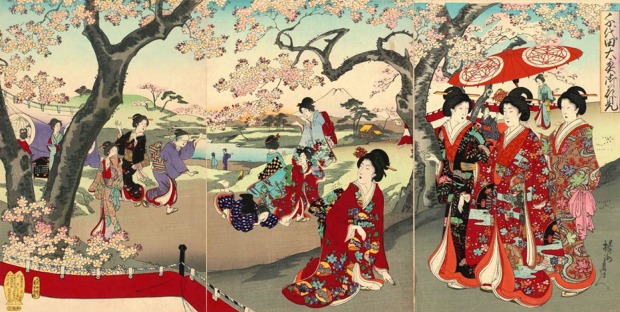
Girl in an Orchard, Maria Dorothy Webb, about 1880:
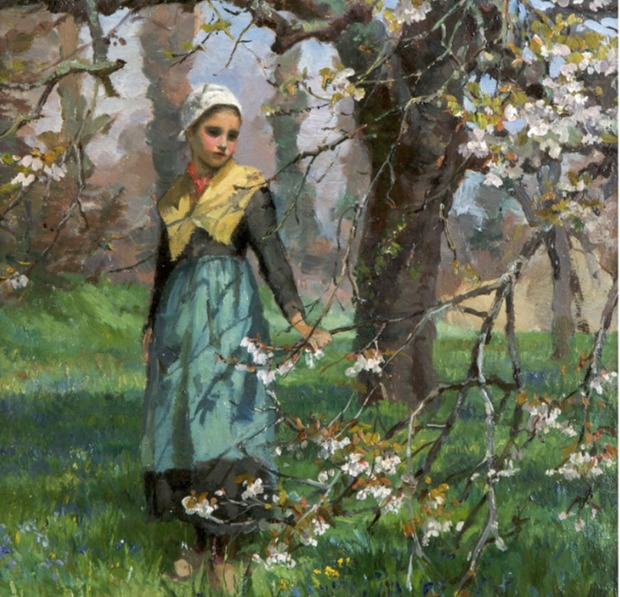
Almond Blossom by Vincent van Gogh, about 1880:
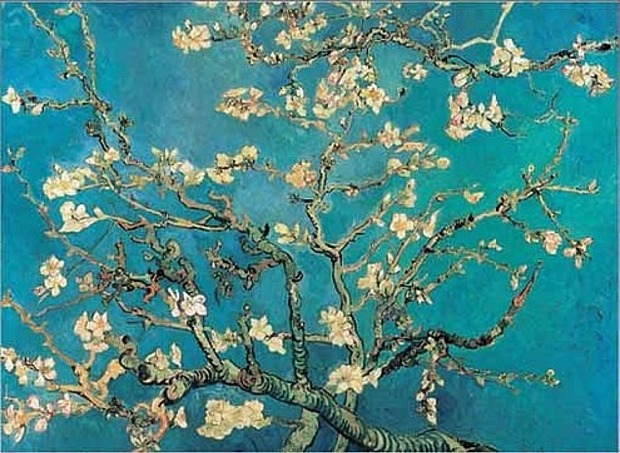
Cherry blossom by Kohji Asakawa:
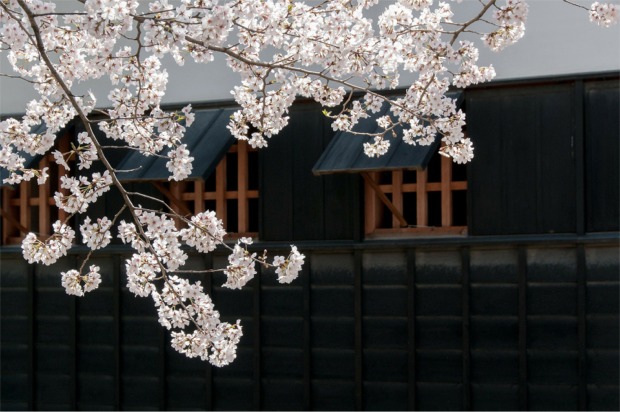
Blossom in the English language
It's a good everyday word that everybody knows.
Literal blossom
The noun blossom: If you're thinking about individual flowers on a fruit tree, you can talk about individual blossoms, but usually "blossom" is a collective noun. One blossom, two blossoms, lots of blossom. "Wow, look at all the blossom on that tree!" or "There's cherry blossom everywhere in the park, you should go and see it."
The verb to blossom: You can talk about a tree "blossoming" or "coming into blossom".
When a tree has lots of blossom, you can say it's "in blossom".
When a non-blossom tree like a magnolia has flowers, you can say it's "in flower":
"The chestnut trees are in flower already."
Metaphorical blossom
" Let us be grateful to people who make us happy, they are the charming gardeners who make our souls blossom." - Marcel Proust
You can also talk about a person "blossoming": "Sarah was very quiet when she was at school, but she has blossomed at university. She's in the theatre group, she plays tennis twice a week, and she's got lots of friends."
Or you can talk about somebody's confidence, skills, abilities, talents or career "blossoming".
Picture credits
1: Japanese cherry blossom, Couleur
2: Magnolia by Margarita Kochneva; horse chestnut by Hans Braxmeier; black locust or false acacia by Satynek
3: Cherry tree in old orchard by Bernswaelz
4: Gorse on coastal heath by Jonathan Davies, Creative Commons BY 2.0
5: Diagram of flower, Nicholas of OnePlanet and Linguetic, Creative Commons BY 2.0
6: Apple blossom and pollinating insect by Julia Schwab
7: Bee dusted with pollen by Sven Lachmann
